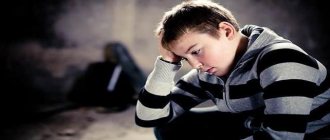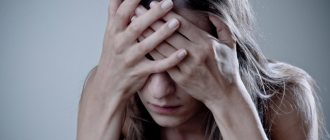Phobia
is called a strong fear that cannot be controlled or rationally explained.
If ordinary fear can be explained logically and thus get rid of it, then phobias are irrational and often arise along with panic attacks. Dealing with a phobia is very difficult, since the cause of its occurrence is often difficult to explain, but timely consultation with a psychotherapist can solve this problem and save a person from uncontrollable experiences and unpredictable actions.
The irrationality of a phobia lies in the fact that a person’s fear of a certain object or phenomenon does not correspond to the actual danger. For example, a huge, aggressive dog poses a threat, and fear for health and life in this case is rational, but a miniature lapdog in a leash and muzzle, which evokes similar emotions, defies explanation. The fear of a dog can be overcome with logical arguments (the dog’s owner is nearby and assures him of his friendliness), but if no one and nothing can calm you down and panic begins, then this is already a phobia.
The symptoms of any type of phobia are similar and resemble the signs of a panic attack:
- strong heartbeat;
- difficulty breathing, suffocation;
- dry mouth;
- increased blood pressure;
- discomfort in the stomach and nausea;
- chest pain or pressure;
- shiver;
- dizziness;
- increased sweating;
- weakness in the legs;
- a feeling of unreality of what is happening or of oneself.
Introduction
Phobia, translated from Greek as “fear,” is only a symptom of an obsessive state. Which arises as a result of experienced trauma, or stressful situations that the psyche for some reason could not cope with.
Characteristics
- The experiences that arise are usually not objective. Let’s say that completely harmless things can cause horror, such as a round cloud in the sky, yellow leaves, or a simple procedure for washing your face in the morning;
- The object of fear itself has clear boundaries, it is defined. That is, it means that a person always knows exactly what he reacted to with horror. And not as it happens, anxiety is felt inside, but the consciousness is not able to identify it. Why is he simply scared, but he doesn’t understand why;
- Most people feel shame for being afraid. As a rule, this happens because they understand how irrational he is and do not want to be considered crazy, not like everyone else.
- Phobias tend to progress rapidly. Let’s say it’s enough for a person to get stuck in an elevator or a pipe at least once. In general, in a confined space - how she will forever remember this incident. At best, he will be wary of approaching such places; at worst, he may stop leaving the apartment altogether.
Types
- Claustrophobia: Fear of being in a narrow, confined space
- Aerophobia: fear of flying
- Arachnophobia: fear of spiders
- Driving phobia: fear of driving a car
- Emetophobia: fear of vomiting
- Erythrophobia: Fear of blushing
- Hypochondria: Fear of getting sick
- Zoophobia: fear of animals
- Aquaphobia: fear of water
- Acrophobia: fear of heights.
- Blood Circulation, Injury and Injection (BII): Fear of blood-related injury
- Escalaphobia: fear of escalators
- Tunnel phobia of tunnels: fear of tunnels
These are far from the only specific phobias. People can develop a phobia of almost anything. Also, as society changes, the list of potential phobias changes. For example, nomophobia is the fear of being left without a mobile phone or computer.
As described in one article, it is “a pathological fear of being left out of touch with technology.”
Signs and symptoms
Physical
At the physical level, a person feels dry mouth, his pulse quickens, tinnitus appears, and problems with breathing, which also speeds up and becomes shallow.
Dizziness and a state of stupor may occur when, due to excessive tension in the skeletal muscles, it is difficult for a person to move, as if he “freezes” in place. Or, on the contrary, chaotic movements appear in case of panic, he loses the ability to control himself at such a moment.
Psychological
Problems with concentration and memory appear, and déjà vu may occur. The personality seems to be in constant anticipation that something bad will happen, that she will definitely be unlucky and that her worst thoughts and fantasies will come true.
This anxiety makes it impossible to relax, causing the body’s resources to be depleted. And in a person, against the background of frustration of the natural need for rest and recovery, irritation begins to accumulate.
Cognitive
Changes occur in the cognitive sphere, which means that the worldview, values, beliefs and thoughts in general change. Let’s say a person decides that he is terminally ill if his heart hurts at least once.
Therefore, he will give up bad habits, if he had any. Will avoid physical activity, socializing with friends, and so on. And this is all in order not to provoke a heart attack.
Behavioral
Habits can be developed that minimize the amount of stress. In this case, we talk about obsessive-compulsive disorder. In short, OCD.
The individual comes up with rituals for himself that he strictly follows in order to avoid panic. For example, if you don’t wash your hands exactly 174 times a day, you won’t even be able to sleep.
This is a severe form of manifestation of neurotic disorders and is included in the list of the international classifier of diseases ICD-10.
Panic attacks can also make themselves felt. These are sudden, causeless attacks of fear that cause a person to have difficulty breathing. Which is even more frightening, since it seems that he is about to suffocate or simply go crazy.
In general, at the moment of exacerbation, a person can become hysterical, cry, beg for help and behave completely unpredictably. And only when she has calmed down and is safe (in her perception) will she be able to realize that the fear was completely irrational and the reactions to it were excessive.
Nosophobia - fear of getting sick
As we said earlier, nosophobia is an obsessive, anxious idea of getting sick with a specific disease, such as coronavirus, cancer, AIDS, or any other disease in general. Those who suffer from this phobia develop an exaggerated fear of the disease and are often depressingly impressed by specific cases of the disease.
Here are some of the symptoms of nosophobia:
- Exaggerated constant nervousness before any minor physical sign. The slightest deviation is considered a symptom.
- A person takes extreme measures to avoid contact with germs and viruses.
- Frequent and repeated visits to different doctors, although they may avoid them as a possible source of infection.
- There is a strong worry that the doctor will confirm their fears that they are suffering from a terrible disease and make a diagnosis.
Obsessive fears of infections and diseases become dominant and manifest themselves at the cognitive level (constant thinking about it). There are also emotional symptoms, such as experiencing dysphoric mood due to intense terror, and behavioral symptoms, such as inappropriate medical consultations.
Origin theories
Psychoanalysis
Psychodynamic theory (the same psychoanalysis) is not scientifically recognized, but it has a good chance of existence. Its essence lies in the fact that a person unconsciously displaces the true causes of fear into the unconscious. And then it transfers it to a previously indifferent object, object.
To make it clearer, I will give an example. A man is afraid of castration or erectile dysfunction (that is, impotence). Why does he repress thoughts about it, hoping that this will never happen to him.
But the experiences don’t actually go away; the charge of energy remains in the body. But he needs to find a way out. In this case, horror may suddenly appear at the sight of spiders, kittens, bright sun, and so on.
Evolutionary
In ancient times, in order to survive, a person had to beware of foreign tribes, even very cute cubs of predators and large animals in general. Heights, fire, cold, darkness, etc. Otherwise, there could be no talk of any evolution; everyone would have died out even then.
Therefore, experts are inclined to believe that even the most ridiculous phobias in modern humans come from our ancestors, which were passed on to us at the genetic level. It’s just that the objects are completely different due to the changing conditions in which we now live.
Genetic
She suggests that the tendency to phobic reactions is inherited. But it’s difficult to judge exactly which way.
That is, a person can be incredibly afraid of blackbirds because his mother suffered from some kind of mental or nervous disorder. This is why he was included in the risk group, since he had a high probability of receiving a similar diagnosis.
Or simply, as a child, he saw how she reacted to birds, which is why he adopted the method of behavior, considering it correct.
Children are not able to process the information received using criticism and logic. Moreover, if an adult is significant to him, he then becomes a role model.
Behaviorist
Behaviorists believe that a person “earns” a phobia during life, denying heredity and so on.
She simply learns to react with fear to certain stimuli that once in the past caused a storm of emotions. Therefore, if you find yourself in a similar situation, a reaction occurs automatically.
Phobia of getting sick
The term "phobia" means a strong obsessive experience and is directed towards a person, an object that may or may not be dangerous. A phobia does not depend on real danger. This word comes from the Greek word Phobos, which means panic. In Greek mythology, Phobos, who was the son of Aphrodite (goddess of love) and Ares (god of war), personified fear. Alexander the Great always prayed to Phobos before battle to get rid of his horrors.
The Diagnostic and Statistical Manual of Mental Disorders (DSM-V) lists nosophobia under phobias.
DSM-V diagnostic criteria for defining a phobia
- Intense anxiety about a specific object (eg, flying, heights, animals, injections, the sight of blood). Note: In children, the experience is expressed by crying, hysterics, catatonic manifestations or clinging.
- The phobic object almost always causes immediate suffering.
- The phobic object or situation is actively avoided or experienced with intense distress.
- Signs of suffering are not commensurate with the real danger posed by the object or situation and with the sociocultural context.
- Persistent anxiety, fear, or avoidance causes clinically significant distress or impairment in social, occupational, or other important areas of functioning. For example, a person refuses a job that involves constant flying due to fears of flying, or cannot undergo a medical examination using MRI due to claustrophobia.
- Avoidance is persistent, usually lasting for 6 months or more.
Causes
Based on the above theories, we can classify the most likely causes of phobias.
- Anxious people usually have a deficiency of gamma-aminobutyric acid, which is called GABA for short. It is the neurotransmitter through which we experience calm. Accordingly, due to its low level, a person is unable to relax, feel safe, etc. GABA levels usually fall with long-term use of medications or any psychoactive substances. Also for brain damage, depression, stress and so on.
- We have already mentioned heredity above. If one of the close relatives suffers from this disorder, then the child has a high probability of encountering similar difficulties and experiences in the future. Plus, he can simply adopt a style of behavior in certain situations.
- In 2013, scientists Brian Diaz and Kerry Ressler proved the existence of so-called genetic memory. That is, reactions that are passed on from generation to generation on an unconscious level, starting from ancient ancestors.
- Various psychological traumas and negative experiences in the past can trigger the appearance of phobias. Even if it’s just a quarrel between parents in front of the child, criticism from a teacher, the loss of a toy, etc., it may well be the cause of mental trauma. That is, a terrible event does not have to happen. At some point, the psyche may not be able to cope with even minor stimuli properly, without any consequences.
What happens in the brain?
Certain areas of the brain store and recall dangerous or potentially fatal events.
If a person encounters a similar event later in life, these areas of the brain retrieve the stressful memory, sometimes more than once. This causes the body to experience the same reaction.
In phobias, the areas of the brain that deal with fear and stress continue to retrieve the feared event inappropriately.
Researchers have found that phobias are often associated with the amygdala, which lies behind the pituitary gland in the brain. The amygdala can trigger the release of fight-or-flight hormones. This puts the body and mind into a state of high alert and stress.
Treatment options
Let’s just say that a person can get rid of “ordinary” anxieties using relaxation or simply breathing techniques. Meditation, rationalization, auto-training, positive affirmations and so on.
Phobias are not so easy to cope with, especially on your own. In this case, visiting a specialist is simply necessary. Because, as stated at the beginning of the article, they tend to grow in scale very quickly.
If a person initially tenses up at the sight of any dog, then correcting his reaction to them will not be difficult.
He may not become an avid dog lover, but at least he will feel calm if the animal is not aggressive towards him. That is, seeing a helpless puppy, it will not run away without feeling the ground under its feet.
But in its advanced stage, this fear threatens to become so irrational that such a person will not be able to sleep, because he will dream of packs of angry dogs. He will be afraid to close his eyes, because in his fantasy they will immediately attack him, crawling out from under the bed and so on.
Then you will have to work for a long time to regain control of your life. So that he can relax and interact with the environment, satisfying his needs.
Types of treatment
Cognitive behavioral therapy
The most commonly used is cognitive behavioral therapy. It allows you to transform negative thoughts into positive ones. And also understand what behavioral stereotypes and reactions are destructive for the client.
That is, they do not allow you to achieve goals and realize needs, receiving satisfaction. Once they are identified, the cognitive therapist will help form new ones. Which will not interfere with its development and existence in general.
Among other things, in the process of therapy you can meet the object of your horror face to face, only in your imagination. Under the supervision of a specialist, the client tries to describe situations when he has panic attacks.
Thanks to modern technologies, it is possible to do this using virtual reality gadgets. Naturally, when a person is already ready for such a turn of events.
Deep work
This does not mean consultations, but direct psychotherapy. This is mainly Gestalt, body therapy, hypnosis and so on.
When working in depth, the psychotherapist strives to find the cause of the phobia. Because working with symptoms alone is useless work. I think you understand yourself. It is important to understand the origins of this condition.
Drug treatment
In some cases, when the patient is truly in serious condition, antidepressants, antipsychotics, or tranquilizers are prescribed. This helps reduce anxiety levels as well as the physical manifestations of anxiety. For example, it helps to nullify the occurrence of panic attacks (hereinafter referred to as PA).
There are specific medications for each type. Let’s say agoraphobia (fear of open space) responds well to benzodiazepines and beta blockers. And if, while experiencing PA, a person becomes violent, antipsychotics work well.
The only thing is that there are specific fears, such as fear of blood, snakes or crocodiles. So, they can only be treated with psychotherapy; they cannot be treated with medication.
In general, as already mentioned, you need to pay attention not only to the symptoms, but it is also important to understand where the roots of the disease come from. Therefore, treatment is usually complex.
Liberation from pathology
Specific phobias do not always require treatment. If the likelihood of meeting the Pope or seeing a gnome is negligible, the patient can hide his worries from others, drive away thoughts about the source of fear. But, if the patient has a fear of time that has developed into depression, the person needs psychotherapy sessions and special medications.
Children's fears are easier to treat than persistent phobias of adults. Parents often ask what to do if their child has phasmophobia, how to get rid of obsessive fear. It is possible that the child watched a movie about monsters and ghosts and now feels frightened when entering an unfamiliar room or a dark corridor. A boy can stop being afraid of ghosts if his mom and dad patiently and tactfully explain to him that such “monsters” do not exist. Humor helps you get rid of fear. By drawing a funny ghost and writing a couple of jokes about it, the child will get rid of painful experiences.
Methods for dealing with panic attacks
As you remember, causeless anxiety usually takes you by surprise. When I was completely unprepared for such a turn of events and calmly, say, drank tea and cookies at a party. And then suddenly it begins to seem that control over the body is lost and that, most likely, death is already two steps away.
This is a truly difficult condition, but it is quite possible to cope with it on your own. So, the main methods that will help you regain peace of mind and the ability to think rationally:
Distracting attention
Judging by the name, I think you guessed that if you have severe anxiety, you should try to distract yourself with something else. Preferably positive and funny.
It is clear that during an attack there is absolutely no time for jokes, but try to occupy yourself with searching for answers to some simple questions. Starting from what day it is, how many windows are in the room, where you are and what color socks the interlocutor is wearing.
It seems like such simple nuances, but they will distract you from your worries. Your brain will actively engage in work, which will allow the body to gradually stabilize. Remember, when emotions run high, the best way to bring them back to normal is rationalization.
If confusion makes it impossible for you to come up with questions and tasks for yourself, switch to sensations. Apply a warm object or a cold object to the skin in different places.
The best, most sensitive places are the stomach, wrist, and temples. Pinch yourself, feel the boundaries of your body. Then you will not think that you are a solid “lump” of horror and anxiety.
Breath
Slow down your breathing. Turn on the timer and try to take such slow and deep breaths in and out that there are no more than 8 to 9 of them per minute. Then try to experiment and breathe first with your diaphragm and then with your stomach. Pay close attention to how your muscles stretch, what you feel and what you think.
You will learn more about calming and stress-relieving breathing techniques in this article. By the way, practice meditation. There is nothing complicated about it, but you will learn to achieve inner balance. You will get the simplest methods designed for beginners from the article about a popular method of meditation.
"Paper bag"
This method is familiar to us thanks to American films. When someone, when experiencing PA, grabbed a paper bag and breathed into it frequently to calm down.
But such a package is not always at hand. Therefore, it will be fine if you just put your palms to your face and try to breathe in them. The effect will be the same.
The secret of this technique is that by exhaling excess oxygen, a person restores the gas balance in the blood. That's why it returns to normal.
Bystander
To control your condition and not do anything stupid. Let’s say, while running around screaming and begging for help, take a piece of paper with a pen and write down everything that comes to mind.
In the process of writing, you distance yourself from your state, as if you will observe it from the side. And this will help put your thoughts in order.
Anger
When anxiety increases, adrenaline is produced in the body. It is he who makes our heart beat at crazy speed. Feeling dizzy due to an increase in the amount of oxygen in the blood, etc.
And in a moment of rage, strong anger, a surge of norepinephrine occurs. It constricts blood vessels and affects blood pressure. In general, in a moment of panic, if you manage to become genuinely angry, you will stop, so to speak, the spinning of the flywheel of uncontrollable horror. And you will gradually return to normal.
You just need to retire and address the PA as a real interlocutor. If possible, say out loud everything you think. About how she got you and how long it will last. The main thing is to do it sincerely.
It is important to clarify that the above techniques allow you to bring your feelings back to normal if you are suddenly seized by anxiety. But if you suffer from a phobic disorder, be sure to consult a specialist.











